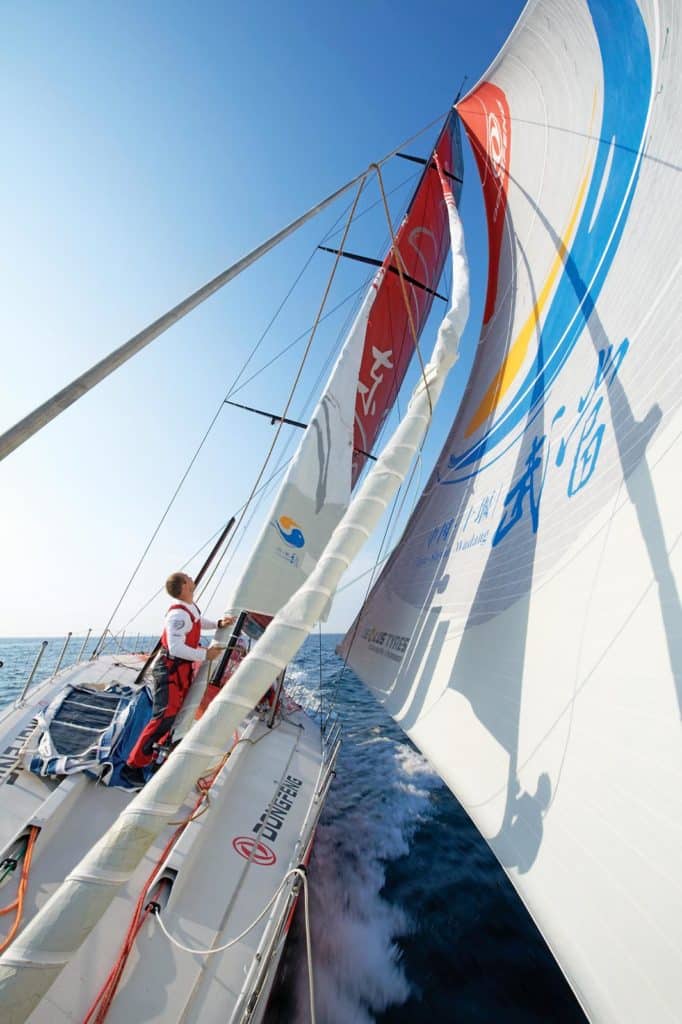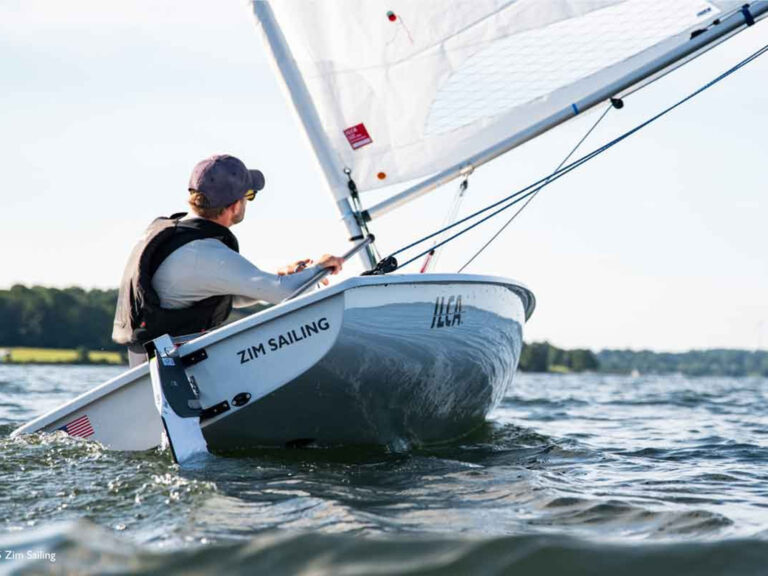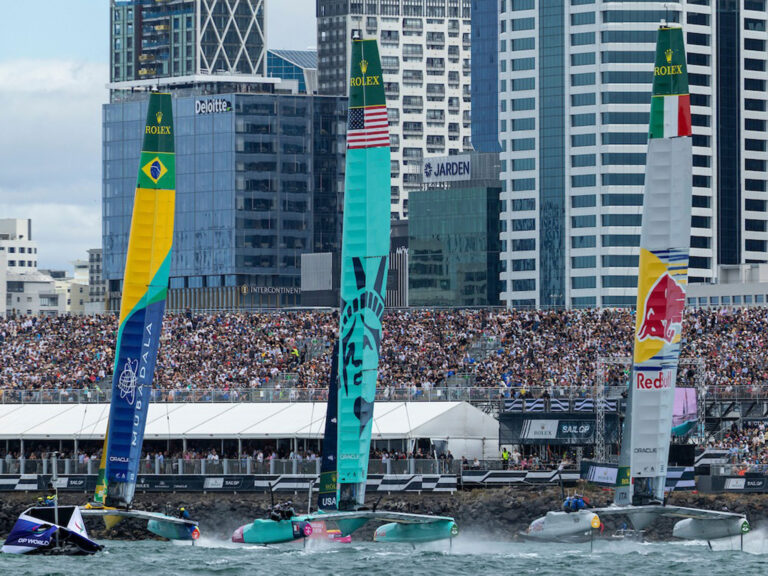
The call of “change the headsail” has resonated with teams since the inception of competitive sailing. I remember one routine summer race day at the J/24 Nationals in San Francisco a number of years back. I was onboard Chris Snow’s boat and doing the bow.
With about six minutes until the start, the fleet was starting to deploy genoas. Then, at about five minutes, came the classic summer San Francisco breeze, all 22 knots of it. Boats charged around the starting line deliberating whether they had enough time to change. You could feel the anxiety in the fleet as teams weighed the options of being grossly overpowered at the start or even the prospect of having no headsail at the start.
There was no deliberating on our boat. Up came the flaked jib and we jumped onto the change. Chris kept maneuvering us close to the line, conscious of the layline to the pin. At about 1 minute, the jib went up and we got a good start toward the pin end of the line. Other teams weren’t as fortunate.
This experience highlights many facets of an effective headsail change. We’ll look at the successful elements behind this dynamic challenge.
For the purpose of this article we will assume we are using headsails with hanks, and that the sail changes will be done before the start, between races, or while sailing downwind with the spinnaker up.
Skipper: If it’s before the start, keep the boat moving well and close to the line. A team will often have a tendency to get sidetracked when changing before the start and sail too far away from the line. If the line is restricted for another fleet, then sail up and down from an extension of the line so you can continue to make observations and enter the area quickly when it becomes your line.
Keep the boat level and the crew as dry as you can. This is not always possible, but it’s something to strive for and it can win important bonus points with the bowman’s union.
Some skippers will get too involved with what the crew is doing with a pre-start sail change and have a disastrous start as a result. Instead, pay attention to the time, what the race committee is up to, and your laylines. Keep the dialogue going with the tactician on where they want to start and encourage continued tactical and strategic observations.
As with any start, keep the boat sailing fast and don’t get involved with the crew work. Let the crew do their thing and keep the boat well positioned against other boats.
Cockpit: The team has to change very quickly before the start. The cockpit person can help reeve the jib sheets through the ratchet blocks and facilitate a quick flake of the headsail. More importantly, they can work with the skipper on monitoring the time, reminding the skipper to stay close to the line, and keeping track of the fleets that have started.
If the tactician is in the middle position, it’s a good idea to have the cockpit person assume the middle person’s role in the sail change before the start. This will free up the tactician to keep looking around and make tactical observations.
Middle crew: If the middle crew is the tactician (as is usually the case in J/24s) and you are changing headsails before the start, consider trading roles with the cockpit person (as noted above) to free yourself to look around and make tactical and strategic observations. Otherwise, bring the new headsail up on deck, and locate and pass the jib blocks to the mast person. Keep monitoring time and stay aware of distance to the starting line. If there’s enough time, help the mast person flake the genoa; if not, store it gently below with the tack facing forward.
If changing on a downwind leg, reeve the jib sheets through the jib blocks; the cockpit person will be preoccupied with trimming the spinnaker. If you are under a lot of time pressure, then reeve only the expected needed (loaded) jib sheet, and be sure to budget a few seconds to make sure it passes through the ratchet block correctly and has a stopper knot in the end. The middle person will also load the jib sheet on to the expected winch (cross-sheeted) and cleat it with the sail eased.
Mast: Take the jib halyard from the bow person and attach to the bale on the mast. When the bowman is extracting the old sail and hanking on the new sail, watch or hold the leech and clew, as these have a tendency to wash over the side in rough conditions. Take the old sail from the bow person and pass the new sail to the bow person with the tack facing forward.
If there’s time, assist the bow and middle (or cockpit) in flaking the sail. If there’s not enough time, pass the sail back to the middle person who can gently store it below with the tack facing forward. If there is a lot of time and it is a permanent change (particularly if the wind is fading toward the end of the day and you are going to the genoa) then you may consider rolling the sail. The mastman will also put the jib blocks to the pre marked setting on the tracks, reeve the jib sheets through, and pass them back (be careful to go under the spinnaker sheets on the port side) to the middle person for reeving through the ratchet blocks.
If necessary, pass the jib halyard forward from the mast bale (look aloft to make sure it isn’t fouled) and be ready with a back-up roll of white tape to tape the halyard snap shackle. The bow person should have this done, but it’s always good to have a backup.
You likely won’t have enough hands to flake the sail when going downwind with the spinnaker flying because you’ll be preoccupied with trimming, positioning, and going fast. In this case, passing the sail back to the middle person for storage (with the tack facing forward) will be the way to go.
Bow: Make sure you stay on the boat. Keep low and move deliberately. Use one hand for yourself, and one for the boat. Retrieve the halyard off and either put it back on the mast bale or pass it back to the middle to attach to the bale.
Un-hank the sail and straddle it between your knees so it can’t fall over the side. Then hank on the new headsail and reattach the halyard, making sure it isn’t fouled aloft. If you use a snap shackle, tape it closed.
It’s a terrific idea to practice changing from jib to genoa and back with your older sails. Do it both downwind with the spinnaker up and also reaching around as if you were in the pre-start area. When coaching teams in practice sessions, I have timed them in both scenarios and we have strived to reduce the time after each practice change. It will pay huge dividends at crunch time. You’ll be focused while others are still scrambling.
Checklist
A quick, clean headsail change is easy if everyone knows the routine. The example here given is for going from a genoa to a jib, but applies to changing up to the genoa, with a few minor differences.
- Mark the jib tracks so that you know where the jib fairlead block has to go.
- Mark the halyard on the jib so you have a basic idea where the halyard tension will go.
- Make sure hanks run smoothly and are not frozen or difficult to open.
- Make sure jib blocks are stored in a commonly known place, which is easily accessible.
- Have both the middle and bow crew have a roll of white tape handy for taping the jib halyard snap shackle.
- Flake the headsail you are not using, fold it into thirds and place a loose sail tie around it. This is much faster than having to unroll the sail under pressure.
- Reeve an extra set of jib sheets on to the headsail you are not using; it saves time.
- Store the flaked headsail with the tack facing forward; doing so will enable you to place it on deck facing the right way.





